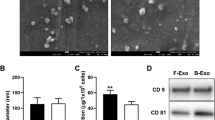Abstract
High-density cell culture is pivotal for the chondrogenic differentiation of human mesenchymal stem cells (hMSCs). Two high-density cell culture systems, micromass and pellet culture, have been used to induce chondrogenic differentiation of hMSCs. In micromass culture, the induced-cartilage tissues were larger, more homogenous and enriched in cartilage-specific collagen II but the fibrocartilage-like feature, collagen I, and hypertrophic chondrocyte feature, collagen X, were markedly decreased compared to those in pellet culture. Furthermore, real time RT-PCR analysis demonstrated that collagen II and aggrecan mRNA were up-regulated while collagen X and collagen I mRNA were down-regulated in micromass culture. Thus, the micromass culture system is a promising tool for in vitro chondrogenic studies.




Similar content being viewed by others
References
Djouad F, Mrugala D, Noel D et al (2006) Engineered mesenchymal stem cells for cartilage repair. Regen Med 1:529–537
Erickson GR, Gimble JM, Franklin DM et al (2002) Chondrogenic potential of adipose tissue-derived stromal cells in vitro and in vivo. Biochem Biophys Res Commun 290:763–769
Fehrer C, Brunauer R, Laschober G et al (2007) Reduced oxygen tension attenuates differentiation capacity of human mesenchymal stem cells and prolongs their lifespan. Aging Cell 6:745–757
Johnstone B, Hering TM, Caplan AI et al (1998) In vitro chondrogenesis of bone marrow-derived mesenchymal progenitor cells. Exp Cell Res 238:265–272
Kafienah W, Mistry S, Dickinson SC et al (2007) Three-dimensional cartilage tissue engineering using adult stem cells from osteoarthritis patients. Arthritis Rheum 56:177–187
Kanichai M, Ferguson D, Prendergast PJ et al (2008) Hypoxia promotes chondrogenesis in rat mesenchymal stem cells: a role for AKT and hypoxia-inducible factor (HIF)-1alpha. J Cell Physiol 216:708–715
Ke H, Wang P, Yu W et al (2009) Derivation, characterization and gene modification of cynomolgus monkey mesenchymal stem cells. Differentiation 77:256–262
Malladi P, Xu Y, Chiou M et al (2006) Effect of reduced oxygen tension on chondrogenesis and osteogenesis in adipose-derived mesenchymal cells. Am J Physiol Cell Physiol 290:C1139–C1146
Mello MA, Tuan RS (1999) High density micromass cultures of embryonic limb bud mesenchymal cells: an in vitro model of endochondral skeletal development. In Vitro Cell Dev Biol Anim 35:262–269
Mueller MB, Tuan RS (2008) Functional characterization of hypertrophy in chondrogenesis of human mesenchymal stem cells. Arthritis Rheum 58:1377–1388
Murdoch AD, Grady LM, Ablett MP et al (2007) Chondrogenic differentiation of human bone marrow stem cells in transwell cultures: generation of scaffold-free cartilage. Stem Cells 25:2786–2796
Pelttari K, Steck E, Richter W (2008) The use of mesenchymal stem cells for chondrogenesis. Injury 39(Suppl 1):S58–S65
Penick KJ, Solchaga LA, Welter JF (2005) High-throughput aggregate culture system to assess the chondrogenic potential of mesenchymal stem cells. Biotechniques 39:687–691
Pittenger MF, Mackay AM, Beck SC et al (1999) Multilineage potential of adult human mesenchymal stem cells. Science 284:143–147
Scharstuhl A, Schewe B, Benz K et al (2007) Chondrogenic potential of human adult mesenchymal stem cells is independent of age or osteoarthritis etiology. Stem Cells 25:3244–3251
Sundelacruz S, Kaplan DL (2009) Stem cell- and scaffold-based tissue engineering approaches to osteochondral regenerative medicine. Semin Cell Dev Biol 20:646–655
Takagi M, Umetsu Y, Fujiwara M et al (2007) High inoculation cell density could accelerate the differentiation of human bone marrow mesenchymal stem cells to chondrocyte cells. J Biosci Bioeng 103:98–100
Tare RS, Howard D, Pound JC et al (2005) Tissue engineering strategies for cartilage generation—micromass and three dimensional cultures using human chondrocytes and a continuous cell line. Biochem Biophys Res Commun 333:609–621
Acknowledgements
This work was supported by the National Natural Science Foundation of China (No. 30971587), the Science and Technology Planning Project of Guangdong Province (No. 2008B030301131) and the Yat-Sen Scholarship for Young Scientists.
Author information
Authors and Affiliations
Corresponding author
Rights and permissions
About this article
Cite this article
Zhang, L., Su, P., Xu, C. et al. Chondrogenic differentiation of human mesenchymal stem cells: a comparison between micromass and pellet culture systems. Biotechnol Lett 32, 1339–1346 (2010). https://doi.org/10.1007/s10529-010-0293-x
Received:
Accepted:
Published:
Issue Date:
DOI: https://doi.org/10.1007/s10529-010-0293-x




